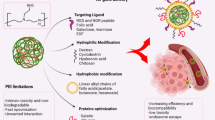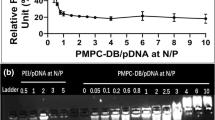ABSTRACT
Purpose
Crosslinked, degradable derivatives of low-molecular-weight polyethylenimine (PEI) are relatively efficient and non-cytotoxic gene delivery agents. To further investigate these promising materials, a new synthetic approach was developed using a poly(4-vinylpyridine)-supported Fe(III) catalyst (PVP(Fe(III))) that provides more facile synthesis and enhanced control of polymer molecular weight.
Methods
Biodegradable polymers (D.PEI) comprising 800-Da PEI crosslinked with 1,6-hexanediol diacrylate and exhibiting molecular weights of 1.2, 6.2, and 48 kDa were synthesized utilizing the PVP(Fe(III)) catalyst. D.PEI/DNA polyplexes were characterized using gel retardation, ethidium bromide exclusion, heparan sulfate displacement, and dynamic light scattering. In vitro transfection, cellular uptake, and cytotoxicity of the polyplexes were tested in human cervical cancer cells (HeLa) and human breast cancer cells (MDA-MB-231).
Results
D.PEIs tightly complexed plasmid DNA and formed 320- to 440-nm diameter polyplexes, similar to those comprising non-degradable, 25-kDa, branched PEI. D.PEI polyplexes mediated 2- to 5-fold increased gene delivery efficacy compared to 25-kDa PEI and exhibited 20% lower cytotoxicity in HeLa and no toxicity in MDA-MB-231. In addition, 2- to 7-fold improved cellular uptake of DNA was achieved with D.PEI polyplexes.
Conclusions
PVP(Fe(III)) catalyst provided a more controlled synthesis of D.PEIs, and these materials demonstrated improved in vitro transfection efficacy and reduced cytotoxicity .









Similar content being viewed by others
REFERENCES
Drumm ML, Pope HA, Cliff WH, Rommens JM, Marvin SA, Tsui LC, et al. Correction of the cystic fibrosis defect in vitro by retrovirus-mediated gene transfer. Cell. 1990;62(6):1227–33.
Kay MA, Rothenberg S, Landen CN, Bellinger DA, Leland F, Toman C, et al. In vivo gene therapy of hemophilia B: sustained partial correction in factor IX-deficient dogs. Science. 1993;262(5130):117–9.
Check E. Gene therapy put on hold as third child develops cancer. Nature. 2005;433:561.
Marshall E. Gene therapy death prompts review of adenovirus vector. Science. 1999;286(5448):2244–5.
Luo D, Saltzman M. Synthetic DNA delivery systems. Nat Biotechnol. 2000;18:33–7.
Park TG, Jeong HJ, Kim SW. Current status of polymeric gene delivery systems. Adv Drug Deliv Rev. 2006;58(4):467–86.
Pack DW, Hoffman AS, Pun S, Stayton PS. Design and development of polymers for gene delivery. Nat Rev Drug Discov. 2005;4:581–93.
Suk JS, Suh J, Choy K, Lai SK, Fu J, Hanes J. Gene delivery to differentiated neurotypic cells with RGD and HIV Tat peptide functionalized polymeric nanoparticles. Biomaterials. 2006;27(29):5143–50.
Ogris M, Brunner S, Schüller S, Kircheis R, Wagner E. PEGylated DNA/transferrin-PEI complexes: reduced interaction with blood components, extended circulation in blood and potential for systemic gene delivery. Gene Ther. 1999;6(4):595–605.
Gosselin MA, Guo W, Lee RJ. Efficient gene transfer using reversibly cross-linked low molecular weight polyethylenimine. Bioconjugate Chem. 2001;12(6):989–94.
Kim YH, Park JH, Lee M, Kim YH, Park TG, Kim SW. Polyethylenimine with acid-labile linkages as a biodegradable gene carrier. J Control Release. 2005;103(1):209–19.
McKenzie DL, Smiley E, Kwok KY, Rice KG. Low molecular weight disulfide cross-linking peptides as nonviral gene delivery carriers. Bioconjugate Chem. 2000;11(6):901–9.
Wong K, Sun G, Zhang X, Dai H, Liu Y, He C, et al. PEI-g-chitosan, a novel gene delivery system with transfection efficiency comparable to polyethylenimine in vitro and after liver adminstration in vivo. Bioconjugate Chem. 2006;17(1):152–8.
Lynn DM, Anderson DG, Putnam D, Langer R. Accelerated discovery of synthetic transfection vectors: parallel synthesis and screening of a degradable polymer library. J Am Chem Soc. 2001;123(33):8155–6.
Forrest ML, Koerber JT, Pack DW. A degradable polyethylenimine derivative with low toxicity for highly efficient gene delivery. Bioconjugate Chem. 2003;14(5):934–40.
Kim EM, Jeong HJ, Park IK, Cho CS, Bom HS, Kim CG. Monitoring the effect of PEGylation on polyethylenimine in vivo using nuclear imaging technique. Nucl Med Biol. 2004;31(6):781–4.
Chari MA, Syamasundar K. Polymer-supported ferric chloride as a heterogeneous catalyst for chemoselective deprotection of acetonides. Synthesis. 2005;5:708–10.
von Harpe A, Petersen H, Li Y, Kissel T. Characterization of commercially available and synthesized polyethylenimines for gene delivery. J Control Release. 2000;69(2):309–22.
Moghimi SM, Symonds P, Murray JC, Hunter AC, Debska G, Szewczyk A. A two-stage poly(ethylenimine)-mediated cytoxicity: implications for gene transfer/therapy. Mol Ther. 2005;11(6):990–5.
Zhong Z, Song Y, Engbersen JFJ, Lok MC, Hennink WE, Feijen J. A versatile family of degradable non-viral gene carriers based on hyperbranched poly(ester amine)s. J Control Release. 2005;109(1–3):317–29.
Kichler A, Behr JP, Erbacher P. Polyethylenimines: a family of potent polymers for nucleic acid delivery. In: Huang L, Hung MC, Wagner E, editors. Nonviral vectors for gene therapy. 1st ed. San Diego: Academic Press, Inc.; 1999. p. 191–204.
Ziello JE, Huang Y, Jovin IS. Cellular endocytosis and gene delivery. Mol Med. 2010;16(5–6):222–9.
Mislick KA, Baldeschwieler JD. Evidence for the role of proteoglycans in cation-mediated gene transfer. PNAS. 1996;93(22):12349–54.
Merdan T, Kunath K, Petersen H, Bakowsky U, Voigt KH, Kopecek J, et al. PEGylation of poly(ethylene imine) affects stability of complexes with plasmid DNA under in vivo conditions in a dose-dependent manner after intravenous injection into mice. Bioconjugate Chem. 2005;16(4):785–92.
Thomas M, Ge Q, Lu JJ, Chen J, Klibanov AM. Cross-linked small polyethylenimines: while still nontoxic, deliver DNA efficiently to mammalian cells in vitro and in vivo. Pharm Res. 2005;22(3):373–80.
Dong W, Li S, Jin G, Sun Q, Ma D, Hua Z. Efficient gene transfection into mammalian cells mediated by cross-linked polyethylenimine. Int J Mol Sci. 2007;8(2):81–102.
ACKNOWLEDGMENTS & DISCLOSURES
This work was supported by the National Institutes of Health (GM085222). Flow cytometry was performed at the Flow Cytometry Facility of the Roy J. Carver Biotechnology Center at the University of Illinois.
Author information
Authors and Affiliations
Corresponding author
ELECTRONIC SUPPLEMENTARY MATERIALS
Below is the link to the electronic supplementary material.
Supplementary Figure 1
NMR spectra of unmodified PEIs and D.PEIs. 1) Unmodified 800 Da PEI, 2) unmodified 25 kDa PEI, 3) D.PEI-48, 4) D.PEI-6.2, and 5) D.PEI-1.2. D.PEI spectrum peak labels: (a) δ = 4.1 ppm, -COOCH 2 , ester linker; (b) δ = 3.5–3.6 ppm, -HOCH 2 , hydrolyzed ester linker; (c) δ = 3.34ppm, methanol residual; (d) δ = 2.47–3.3 ppm, CH 2 CH 2 N, PEI ethylenes; (e) δ = 2.33–2.47 ppm, CH2CH2NHCH2CH 2 COOCH2, ester linker; (f) δ = 1.40–1.60 ppm, -COOCH 2 CH 2 , ester linker; and (g) δ = 1.25–1.40 ppm, -COOCH2CH2CH 2 , ester linker. (DOC 167 kb)
Supplementary Table I
Polymer Concentrations, Viscosity Measurements, Reduced Viscosities, and Molecular Weights of Biodegradable PEI. (DOC 37.5 kb)
Rights and permissions
About this article
Cite this article
Shum, V.W.T., Gabrielson, N.P., Forrest, M.L. et al. The Effects of PVP(Fe(III)) Catalyst on Polymer Molecular Weight and Gene Delivery Via Biodegradable Cross-Linked Polyethylenimine. Pharm Res 29, 500–510 (2012). https://doi.org/10.1007/s11095-011-0576-5
Received:
Accepted:
Published:
Issue Date:
DOI: https://doi.org/10.1007/s11095-011-0576-5




